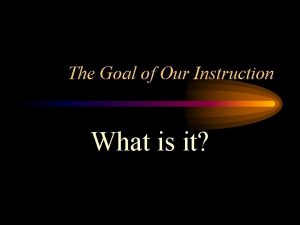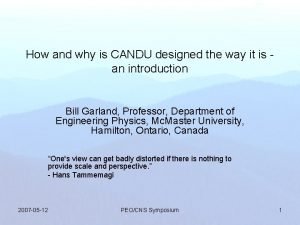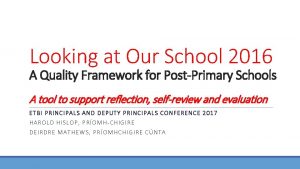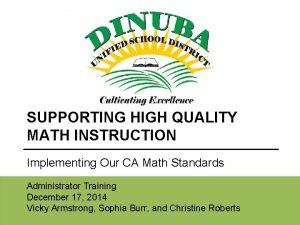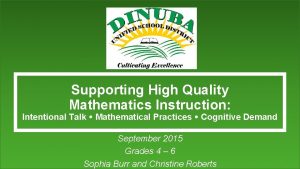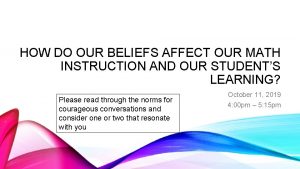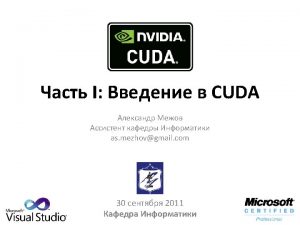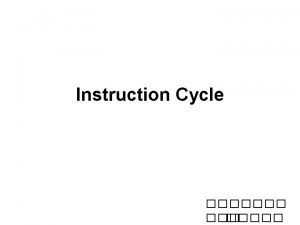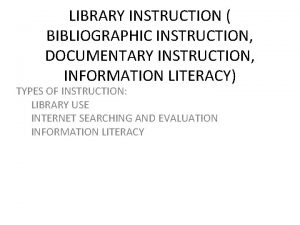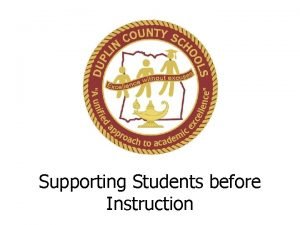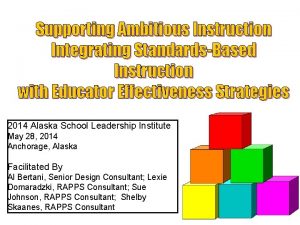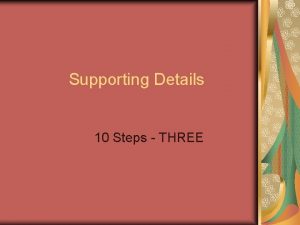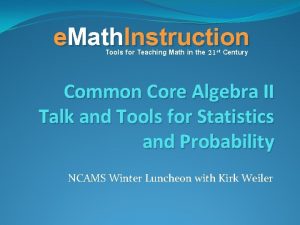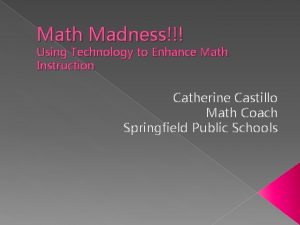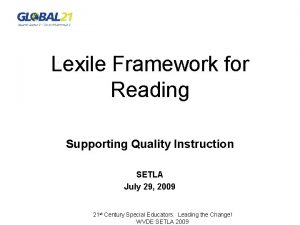SUPPORTING HIGH QUALITY MATH INSTRUCTION Implementing Our CA





























- Slides: 29

SUPPORTING HIGH QUALITY MATH INSTRUCTION Implementing Our CA Math Standards Math Leadership Visits September 2015 Vicky Armstrong, 1

Outcomes • Understand the purpose of Math classroom visits • Find out what was learned about Math instruction and student learning by our leaders last year • Connect the Math classroom visits to our vision for instruction and assessment • Learn what resources in the Math Strategies booklets support our vision for Math instruction 2

DUSD Mathematics Vision Statement Through high quality mathematics instruction and assessment, DUSD students will have the mathematics content knowledge, conceptual understanding, and problem solving ability to succeed in college and career. 3

4

Why are we using the Math Walkthrough Tool during Math visits? • To strengthen administrator knowledge of the Standards for Mathematical Practice and the CCSS Instructional Shifts. • To gather classroom evidence to inform and adjust our support and professional development for teaching and learning. • To share feedback with teachers to promote continuous growth in our implementation of the math standards 5

1 st Purpose… • To strengthen administrator knowledge of the Standards for Mathematical Practice and the CCSS Instructional Shifts. • Most administrators haven’t been in the classrooms as teachers during the shift to Common Core • To lead and support the change, we need to understand the change. 6

“The Math Walkthrough Tool and visits allowed me to focus on what was being learned by the students instead of the focus being on the teachers presentation of the lesson. I was able to have a deeper understanding of the Standards for Mathematical Practices (SMP). The collaboration with a peer after the visit allowed me to solidify what I witnessed as well as see the perspective of someone else. “ WHAT OUR PRINCIPALS ARE SAYING… 7

“I gained a better understanding of the mathematical practices specific to #5 and #7. Also, it made me look at the mathematical content standard and made me see if the lesson/standard was above/on/below grade level. This really helped me learn the math content standards at each grade. WHAT OUR PRINCIPALS ARE SAYING… 8

“As a leader, I was able to see where I needed to focus our efforts for the upcoming months and upcoming year. ” WHAT OUR PRINCIPALS ARE SAYING… 9

“Observing the classrooms really helped me to focus on the student learning process. Focusing on the student engagement helped me to see how the students were learning or internalizing the math processes. ” WHAT OUR PRINCIPALS ARE SAYING… 10

“I began to develop a better understanding of the Standards for Mathematical Practice and as a result what I should see students doing. . It helped me become able to give more useful feedback to teachers. ” WHAT OUR PRINCIPALS ARE SAYING… 11

2 nd Purpose… • To gather classroom evidence to inform and adjust our support and professional development for teaching and learning. • If as a district, we can create a clear picture of where we are, we will know how to support to get to our desired reality. • This picture shouldn’t only be captured through assessment scores but through your feedback and watching real time math instruction. 12

3 rd Purpose… As our site leaders grow in their understanding of the standards and shifts, it allows them to do the following: To share feedback with teachers to promote • Have rich conversations with you continuous about teaching and learning growth in our implementation of • Provide you support in the form of PD opportunities, materials, and the math time standards 13

Walkthrough Tool 14

What are our leaders looking for? The difference between a Math Lesson and a Math Routine The Learning Target and whether it’s taught at the depth of the grade level standard Student Use of the SMPs Rigor of the lesson – Conceptual, Procedural, Application Makes the mathematics of the lesson explicit by using explanations, representations, and/or examples Strengthens all students’ understanding of the content by sharing a variety of students’ representations and solution methods 15

How do these areas connect to our vision for instruction and assessment? Share with an elbow partner and then we’ll share out. 16

Routines and Math Lessons Math Routine Math Lesson A daily focused 10 -15 minute math routine • Number Talks • WMP? WMV? • Choral Counting • Counting Circles • Calendar Routines • Fluency Games • Problem of the Day • Shape Talks A lesson is the planned mathematics activity for the day with a focus on a standard or a few related standards. It should last 4560 minutes. Pgs. 44 -71 provide info on Math Routines 17

Learning Targets • To describe the learning target being taught – eg. Area model for multiplication, addition with place value blocks, finding the area of quadrilaterals • To be able to search the standards application to see which standard is being taught • This process is really helping our principals learn the new content standards 18

Lesson Focus The lesson focuses on the depth of gradelevel cluster(s), grade-level content standards or part(s) thereof. Was the standard taught at the depth intended in the standards? If not, it might be an intentional decision by the teacher scaffold or accelerate content • Yes based on student needs. • No – Below grade-level However, if it happened over and over again in a classroom, • No – Above grade-level the teacher might need support in understanding that particular standard or how to • Unclear teach it at the right level and 19

Standards for Mathematical Practice Overarching Reasoning Habits of Mind & Explaining 1. Make sense of problems and persevere in solving them. 6. Attend to precision. 2. Reason abstractly and quantitatively. 3. Construct viable arguments and critique the reasoning of others. Modeling & Seeing Structure Using Tools & Generalizing 4. Model with mathematics. 7. Look for and make use of structure. 5. Use appropriate tools strategically. 8. Look for and express regularity in repeated reasoning. 20

Math Strategies Book • Look through pages 16 – 26 with a partner. – What types of resources are included? – How might you use these resources to deepen your use of the SMPs? 21

Rigor in Mathematics • Rigor in mathematics focuses on the following aspects of mathematics with equal intensity: conceptual understanding, procedural skill/fluency, and application. – Conceptual understanding – Procedural skill and fluency – Application to the real world or other math content 22

Teacher uses Explanations, Representations, and Examples A variety of instructional techniques and strategies are used to make the mathematics of the lesson clear. Pgs. 4 -15 & 87112 provide information on techniques and strategies 23

Teacher uses Explanations, Representations, and Examples - Sample • • • When working with multiplication, the teacher connects the visual model of equal groups to the context of the story problem, asking students to explain why they represented this story with 8 equal groups of 4. The teacher asks students if the problem could be represented in another way. The students discuss their ideas with a partner and the teacher asks several groups to share another representation of 8 x 4, asking students to describe how their representation connects to the story problem. The teacher ends the discussion by having a student share the equation she created to solve the problem. The teacher asks the students to make connections between the visual models shared and the equation. 24

Sharing Student Representations and Methods A variety of student solution methods are shared and examined together to support mathematical understanding for all students. The teacher strategically layers the solution methods from the most concrete to the most abstract, supporting all students in connecting their mathematical ideas. Pgs. 13 provides information on how to do this during the summarize portion of the lesson. 25

Sharing Student Representations and Methods - Sample • The teacher selects 3 students to share their work with the class. • Each of the students chose a different representation to complete the problem. • The teacher sequences the student sharing starting with the most concrete representation and moving to the most abstract representation. • After all three students have shared, the teacher asks the students to compare and connect the strategies used with questions like: In what ways, are the representations alike? How are they different? Where do you see the solution in each of these strategies? 26

This Year’s Classroom Math Visits • Site administrators will continue to visit 4 th grade and 7 th on their own campuses 2 -3 times a year. • Elementary site administrators will add 1 st and 5 th grade math visits and may do that in tandem with another site administrator or district leader. They will visit 2 -3 times a year. • Secondary site administrators will add 8 th and 9 th grade to the math visit list. 27

Remember Our Three Purposes • To strengthen administrator knowledge of the Standards for Mathematical Practice and the CCSS Instructional Shifts. • To gather classroom evidence to inform and adjust our support and professional development for teaching and learning. • To share feedback with teachers to promote continuous growth in our implementation of the math standards 28

Did We Meet Our Outcomes? • Understand the purpose of Math classroom visits • Find out what was learned about Math instruction and student learning by our leaders last year • Connect the Math classroom visits to our vision for instruction and assessment • Learn what resources in the Math Strategies booklets support our vision for Math instruction 30
 Differentiated instruction vs individualized instruction
Differentiated instruction vs individualized instruction Direct vs indirect instruction
Direct vs indirect instruction The goal of our instruction is love
The goal of our instruction is love Thinking affects our language, which then affects our:
Thinking affects our language, which then affects our: Our census our future
Our census our future Bernadette farrell christ be our light
Bernadette farrell christ be our light Marcus aurelius our life is what our thoughts make it
Marcus aurelius our life is what our thoughts make it We bow our hearts we bend our knees
We bow our hearts we bend our knees Our census our future
Our census our future Our life is what our thoughts make it
Our life is what our thoughts make it Summary poem money madness poem
Summary poem money madness poem Awareness of ourselves and our environment is:
Awareness of ourselves and our environment is: Our awareness of ourselves and our environment is called
Our awareness of ourselves and our environment is called God our father christ our brother
God our father christ our brother Our future is in our hands quotes
Our future is in our hands quotes Our awareness of ourselves and our environment.
Our awareness of ourselves and our environment. Is our awareness of ourselves and our environment.
Is our awareness of ourselves and our environment. Quality is our top priority
Quality is our top priority Quality is our top priority
Quality is our top priority Looking at our school 2016 a quality framework
Looking at our school 2016 a quality framework Hrd program implementation and evaluation
Hrd program implementation and evaluation Implementing strategies management and operations issues
Implementing strategies management and operations issues Implement strategies management issues
Implement strategies management issues Implementing strategies: management and operations issues
Implementing strategies: management and operations issues The pricing tripod
The pricing tripod Implementing merchandise plans
Implementing merchandise plans Designing and implementing branding strategies
Designing and implementing branding strategies Designing and implementing brand marketing programs
Designing and implementing brand marketing programs Porfolio assessment
Porfolio assessment Planning and implementing crm projects
Planning and implementing crm projects


